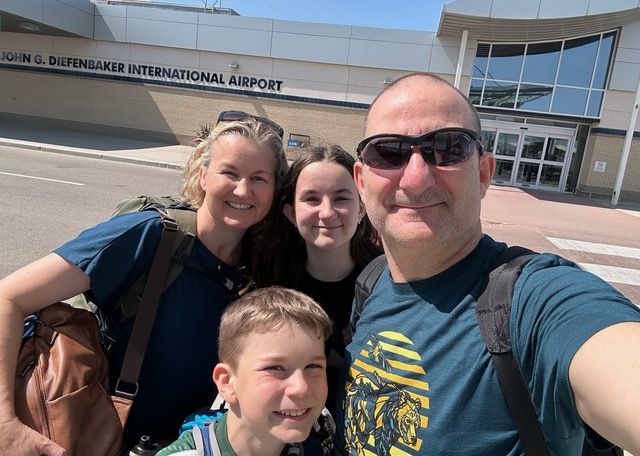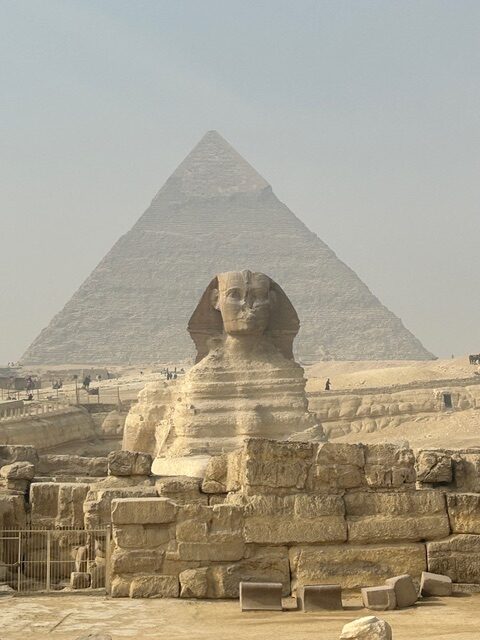Cairo a massive city of 20 or 25 million, the sixth largest city in the world, it was quite overwhelming. We were very grateful that our AirBnb host had suggested his driver, Moamen pick us up at the airport for good price, thus we did not have to navigate the chaos at the airport or the public transport system. The AirBnb owner, an elderly German gentleman, who has lived in Egypt for over forty years, became friends with Moamen many years ago. He encouraged him in his education to become a licensed tour guide and now helps him find customers in this highly competitive market, through his AirBnbs.
The outside of our AirBnb was beautiful, inside the 1920s building needs a lot of work . The actual apartment had been fully renovated with great detail paid to matching the original style and furnishings. The kids were thrilled to each have their own room for the first time in ages, we all appreciate having enough space to really focus on catching up with school and other work. Our location was central, and we were able to walk to the famous Tahrir Square (Liberation Square) and the Egyptian Museum of Antiquities on our first day. The pedestrian experience in Cairo is unique, it is incredibly busy, the traffic seems to follow few rules, pedestrians have no rights! We met several “nice people” along the way to the museum, they were anxious to help us with the crazy “game of chicken” you play trying to cross the street. You are encouraged to make direct eye contact with the drivers, then head out into the road despite the non-stop traffic; we quickly took to following the locals very closely. Although the “nice people” along the way were friendly and helpful, we quickly learned they wanted to then escort us to stores where they were destined to get a commission. The traffic noise and massive amount of people was a shocked to our senses (despite coming from Istanbul); Sophie received much more unwanted male attention, understandably this was a little unnerving for her. We quickly agreed to only travel outside our apartments as a family four because it felt safer. While walking, every few blocks we would come across multiple armed military trucks with soldiers in riot gear (see image below). The downward spiralling economy and some of issues that contributed the 2011 revolution and 2013 protests are clearly ongoing.
The Egyptian Museum was great. It is an old mansion two floors, filled with artifacts (despite what has been take to the British Museum, London). We saw a huge number of mummies, sarcophagus and burial coffins. Many stone carvings, statues, and monuments. There was an amazing selection of artifacts from the King Tutankhamun’s Tomb (no pictures allowed in this area). There was minimal written information at the museum, in retrospect this museum would be a good museum to hire a guide. We chose to visit this museum, but there is also newer National Museum of Egyptian Civilization which would have been more informative, but we also wanted to see the famous Tahrir square.
The next morning, our guide Moamen picked us up at 9 AM to travel through crazy traffic to the opposite side of the Nile and the city of Giza. Seeing the pyramids was amazing, unfortunately, the morning was quite foggy thus our view was somewhat limited. The clouds lifted occasionally to give us a true understanding of the magnificence of these ancient world wonders. As the morning went on more of the clouds lifted and we had a better view of the Sphinx. Our tour guide’s English was a little bit limited, but he was very helpful. We supplemented our learning with the Pyramid Ted Ed, which was fantastic and Brennen Fraser’s movie, The Mummy. On our final day in Cairo, we visited a local Cairo Souk looking for a few more gifts. It was bustling with people, some funny and somewhat aggressive salesman and many local shoppers. This Bazar is located on the edge of a huge, beautiful mosque (better maintained than many of the other buildings in Cairo), many are clearly falling into disrepair. Our guide has shared with us that most of the money for infrastructure in Egypt has been spent on the development of the “New Administrative Capital”, 60 km from Cairo. The city began construction in 2015, and this continues to be the focus for development funds. There is clearly a need for more investment in local infrastructure, healthcare and education. Unfortunately, with the Suez Canal closed for the last few months due to the surrounding wars, the decrease in tourism secondary to the surrounding wars the economy is in a bad recession and the country is experiencing severe inflation.



















